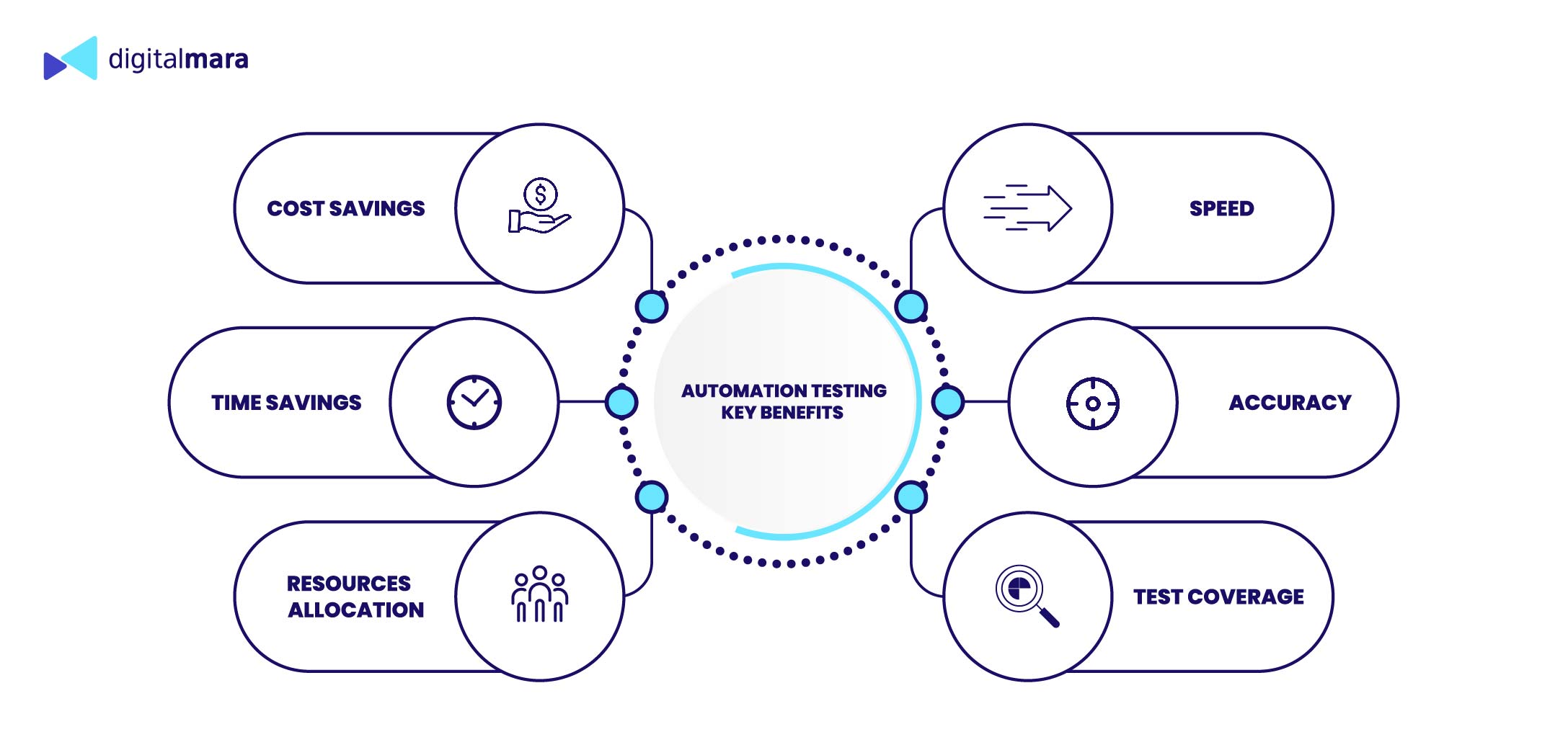According Global Market Insights, the automation testing market is valued at $20 billion in 2022 and is expected to show a compound annual growth rate of more than 15% till 2032. Companies are investing big budgets into their software products, and proper software testing is a crucial part of the development lifecycle. Manual testing can’t fill all the gaps and may result in losses. Automation testing brings undoubtable value, saving resources that might be allocated to more important business tasks. The DigitalMara team has defined why automation testing is so important, and collected some useful tips and key benefits.
Automation isn’t limited to just certain types of software. You can employ it for web, mobile, cloud and embedded applications. But that doesn’t mean you can completely exclude manual testing. Some scenarios do still require doing tests by hand, such as exploratory tests, one-time tests, and user experience tests for usability.
However, automated tests are great for regression testing, smoke testing, data-driven testing, cross-browsing testing, performance testing, user flow testing and more. There are several scenarios when using automated tests might even be obligatory in the quality assurance process. One should automate when:
- the project is large-scale and long-term;
- you need to test the same area time and time again;
- there are short iterations and frequent releases on the project;
- you need to support the old version of your software;
- the software is processing large amounts of data.
Key benefits of automation testing
What makes an automated approach so helpful? It decreases operational risks and the impact of human factors and allows for monitoring everything on the move. Using automation, it’s possible to generate a wide array of test cases for many potential scenarios and check functions that work with various data sets.

- Increased test coverage
With each fresh build, you need to be sure no bugs are hidden in newly added features, and at the same time be sure these modifications aren’t ruining the current version. The code volume for testing is growing. Instead of handling a large volume of extra tests, automation can empower regression testing to make accurate and high-volume checks after each release.
All automated test scripts are for multiple-use. That saves time and effort. Also, you can test systems and components in parallel, making sure everything is running properly in different browsers and devices.
- Improved accuracy
Automated test scripts can take the same actions dozens of times without vision blur and identify errors often missed by manual testing, such as memory leaks. If bugs go undetected for a long time, this raises the cost of fixing them. With automated testing, you may enhance the quality of the system, reduce general risks and more easily follow the progress of the development process.
- Detection of bugs in early stages
Developers spend precious hours debugging software malfunctions, and that costs the company money. Moreover, some bugs may appear only after software has come into operation and gets its first users. Such a situation causes both reputational and financial losses. Automated tests scan code while it is being compiled and send feedback immediately. The sooner the bug is detected, the easier and cheaper it will be to eliminate it.
- Faster testing – faster delivery
Automation makes it possible to run several tests simultaneously, including during non-working hours. Things simply go faster. This speed also allows for testing more conditions and extreme instances. Adding new features to your app means more stuff to test, and manual tests take time and resources, particularly on the financial end. Reducing testing time is critical for fast product delivery.
Artificial Intelligence for testing
Artificial Intelligence and Machine Learning algorithms are capable of enhancing automation testing with more coverage, speed and reliability. This approach is good for continuous testing and creating specific and unique scenarios. For example, AI is able to perform pixel-level recognition and analysis of dynamic UI elements.
Advantages:
- Efficiency – decrease and remove recurring and tiring tasks.
- Resources – cut time for testing and tester participation in routine tasks.
- Performance – enhance processes and total performance.
- Risks – significantly reduce operational risks.
Tools examples: Applitools, Parasoft, Test.ai
Codeless (low-code) test automation
A low-code approach enables setting up, running and analyzing end-to-end automated tests with little or no coding. And doing it quickly. “Drag and drop” commands simulate users’ interactions with your app.
Advantages:
- Easy to use – as it doesn’t require deep technical knowledge, non-professionals can handle tests and spend less time doing them.
- Agility – changes are made easier with no need to rewrite whole code.
- Resources allocation – with no need to write code for regression test automation and UI tests, testers can spend more time on exploratory tests and other tasks.
Therefore, this approach has some limitations. The platform functions may not be enough to carry out complex test scenarios, especially when tests are not modular or readable. Also, they can’t be customized for specific use cases.
Tools examples: BrowserStack, Mabl, Testim
Cloud-based testing
The cloud-based approach is based on cloud technologies. It features fast setup of the infrastructure, which allows you to concentrate on the execution. Cloud testing tools also have features that enable geo-location testing.
Advantages:
- Scalability – easy to create numerous testing environments and conduct large-scale testing.
- Versatility – ability to emulate an operational environment, including close to real-world conditions.
- Collaboration – any team member has access to the cloud testing environment and can make changes at any stage.
Tools examples: AppPerfect, Nessus, Testsigma
Conclusion
Automation can be costly and takes some effort to implement, including the presence of skilled developers. But its high-end and efficient testing process makes it worth the trouble. You will get a return on your investment through faster delivery of a higher quality application and customer satisfaction with your product. Thanks to end-to-end tests, automation testers don’t need to do recurring and monotonous tasks. Instead, they can do tests that really require their attention and effort, and that improve the project. Together with manual testing, automation brings more value to the development process.
DigitalMara has vast experience in automation testing for projects from various industries, such as ecommerce, healthcare, and telecommunication. We do test planning and tools selection, set up test environments and create test scripts, and carry out maintenance and reporting. We use a modern toolkit for automation, such as Selenium, JUnit, RobotFramework, Mockito, and QUnit, and conduct various test types.

































